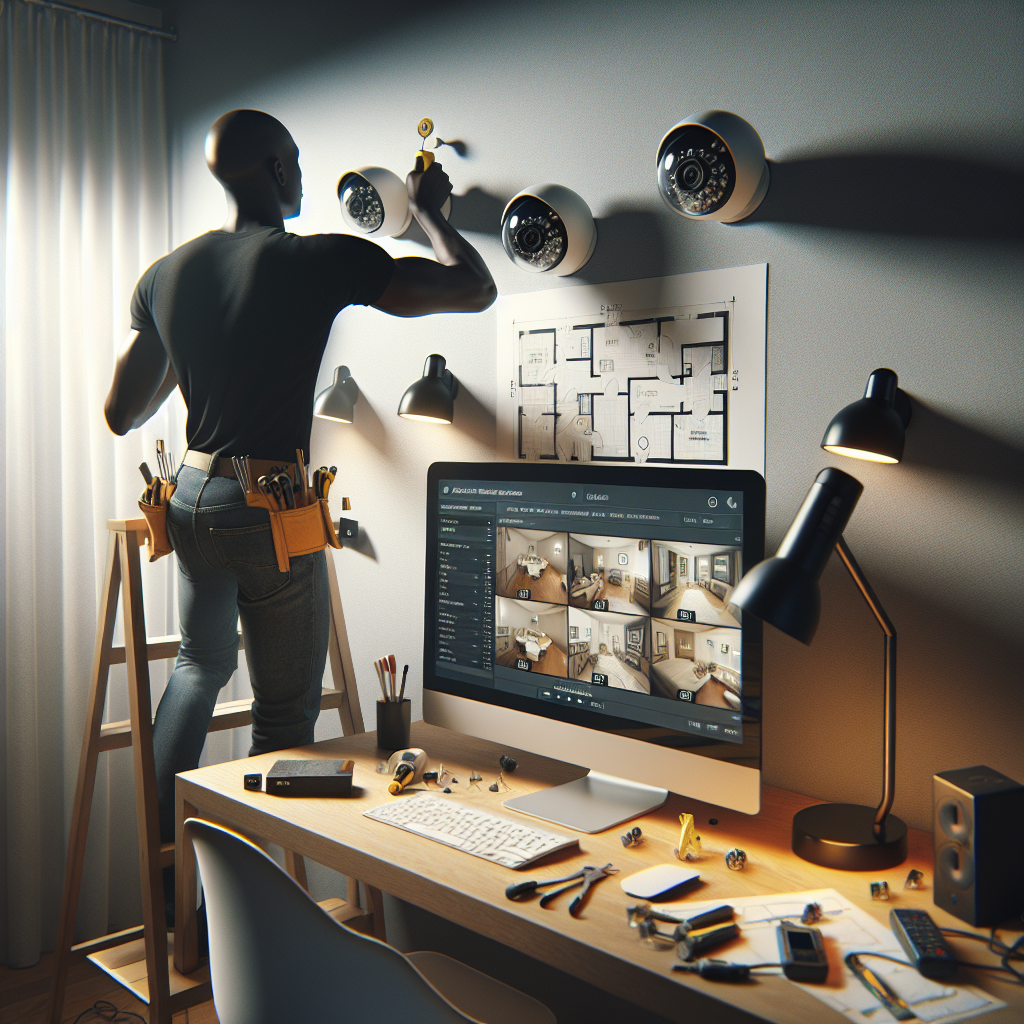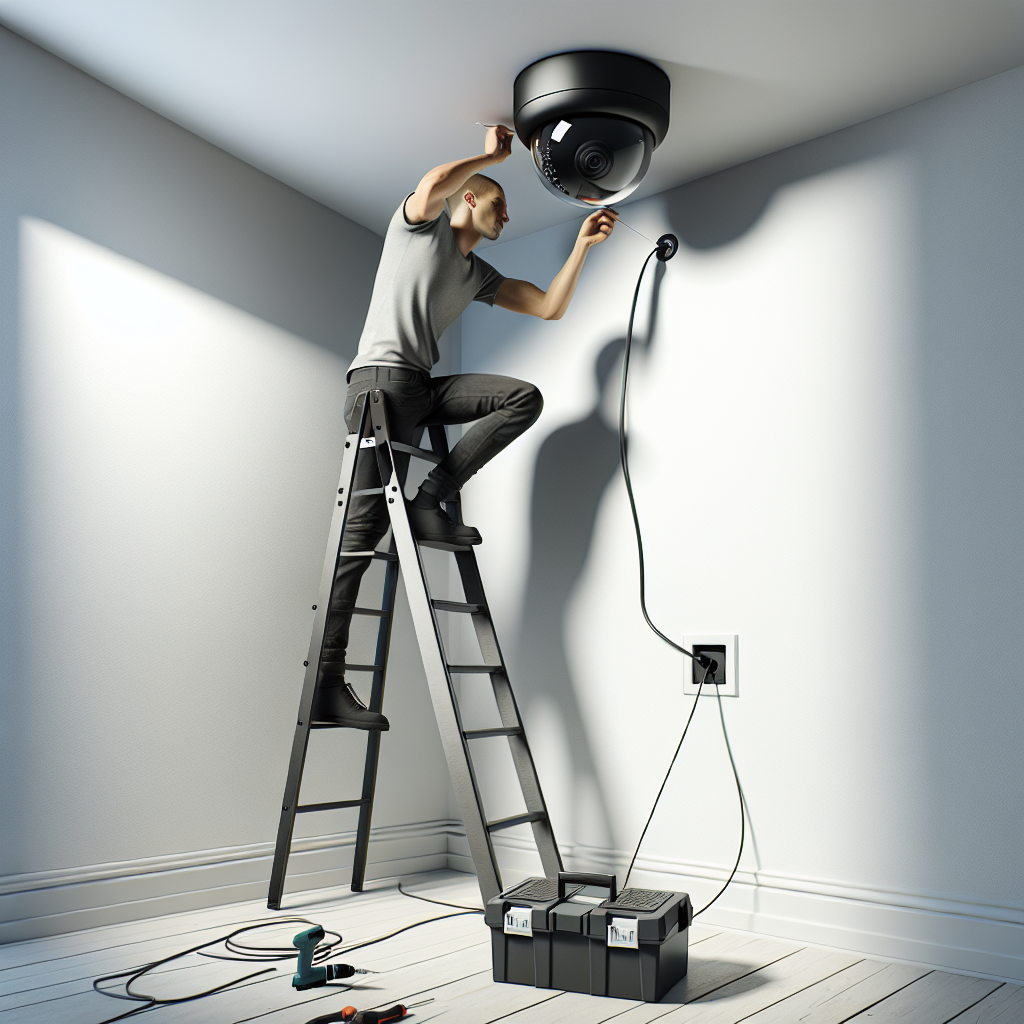Embarking on a journey to enhance the security of your property begins with understanding the basics of security camera installation. This task, while seemingly daunting, can be broken down into manageable steps. The first step is to determine the optimal positions for camera placement, ensuring maximum coverage and deterrence of unwanted activity. The type of security camera selected—be it wired or wireless—will also impact the installation process.
Once the planning stage is complete, the next phase involves the physical installation of the cameras. This includes mounting the cameras, running cables if necessary, and ensuring they are properly powered. For wired systems, this could mean routing cables through walls or along the perimeter of a room. Wireless systems, on the other hand, require a robust Wi-Fi network and strategic placement to avoid signal interference.
After the cameras are in place, they must be connected to a recording device or network. Configuring the system for remote viewing is also a crucial step, allowing for real-time surveillance from smartphones or computers. Lastly, the system needs to be tested thoroughly to ensure all components are functioning correctly and the coverage areas are satisfactory.
Are you ready to secure your premises with professional security camera installation? Your peace of mind is just a click away. Visit our website to learn more and get started today! Click here.
Selecting the Perfect Spot for Your Security Cameras

Choosing the ideal locations for security camera installation is a critical step that significantly influences the effectiveness of your surveillance system. To begin, assess the areas that are most vulnerable to security breaches, such as entrances, exits, and windows. High-traffic areas within the premises also warrant camera placement to monitor the flow of people and activities.
It is equally important to consider the field of view for each camera. Wide-angle lenses cover larger areas, reducing the number of cameras required, while more targeted spots may need cameras with zoom capabilities. Additionally, the camera’s position should be out of reach to prevent tampering but still accessible for maintenance purposes.
Environmental factors play a role in placement decisions as well. Cameras should be shielded from direct sunlight and extreme weather conditions to prevent damage and ensure clear footage. In outdoor scenarios, opt for cameras with strong weatherproof ratings. Lastly, ensure that cameras are placed in a manner that respects privacy laws, avoiding areas where individuals have a reasonable expectation of privacy.
In conclusion, strategic placement of security cameras is imperative for optimal surveillance. Careful planning and consideration of various factors will lead to a more secure and efficient security system.
Choosing the Right Security Camera System for Your Needs

Selecting the right security camera system is paramount to ensuring the safety and surveillance of your property. Begin by evaluating your security goals: do you need to monitor the exterior of a building, keep an eye on internal operations, or both? The answer will guide your choice between outdoor, indoor, or combination camera systems.
Resolution and image quality are key factors. High-definition cameras provide clearer images, which can be crucial for identifying details such as faces or license plates. Night vision capabilities are essential for round-the-clock surveillance, while motion detection features can save storage space and make it easier to review footage.
Consider the scalability of the system. If you anticipate your security needs will grow, a system that allows additional cameras to be added seamlessly will be advantageous. Connectivity is another critical aspect – wireless systems offer flexibility and easier installation, whereas wired systems are often more reliable and better suited for permanent setups.
Storage solutions should not be overlooked. Cloud storage services offer remote access and reduce the need for physical storage devices, but ensure that the service provides adequate encryption and data protection. On the other hand, local storage can be more cost-effective and eliminates the need for ongoing subscription fees.
Finally, integration with other smart home devices and systems can enhance your security ecosystem. Look for cameras that can connect with your existing home automation for added convenience and control. By considering these factors, you can choose a security camera system that meets your specific needs and provides peace of mind.
Step-by-Step Guide to Installing Security Cameras

Installing security cameras can seem daunting, but with a structured approach, you can secure your premises effectively. Here is a step-by-step guide to help you with the installation process:
- Plan Your Camera Layout: Identify critical areas that need monitoring and ensure camera placement covers these zones without obstruction. Keep in mind the field of view and potential blind spots.
- Select the Mounting Positions: High positions are ideal for a wider view range and to keep cameras out of reach. Make sure the cameras are pointing in the correct direction and angle for optimal coverage.
- Install Mounting Brackets: Secure the brackets firmly to the wall or ceiling, using proper anchors for the material you’re mounting on to ensure stability.
- Arrange for Power Supply: If you’re using wired cameras, run the cables to the power source. For wireless models, ensure they are within range of the Wi-Fi network and have access to power outlets.
- Connect to a Recording Device: Attach the cameras to a DVR or NVR system if you’re using a wired setup. For IP cameras, connect them directly to your network.
- Adjust the Camera Settings: Configure the settings according to your needs, such as resolution, motion detection sensitivity, and recording schedules.
- Test the System: Verify the camera feeds to ensure they’re capturing the desired areas and that the image quality meets your expectations.
Keep in mind local regulations regarding privacy and consent when setting up your cameras. It’s essential to ensure your security system operates within legal boundaries to avoid any future issues. With these steps, you’ll be on your way to a more secure property.
Essential Tools and Equipment for Security Camera Installation

To ensure a smooth and efficient installation of your security cameras, having the right tools and equipment is crucial. Here’s a list of essentials that you’ll need to complete the job:
- Drill and Drill Bits: A power drill is necessary for mounting cameras and brackets to walls or ceilings. Select drill bits that are appropriate for the surface material.
- Screwdriver Set: Various screw types may be used in camera mounting, so a versatile screwdriver set is beneficial.
- Wire Strippers and Crimping Tools: If you’re working with wired cameras, these tools will help prepare and connect the cables.
- Ladder: For installing cameras at high positions, a stable ladder is indispensable for safety and reach.
- Measuring Tape: Accurate measurements are key to properly spacing cameras and running cables.
- Level: A level ensures your cameras are installed straight, providing a professional appearance and proper function.
- Cable Tester: This tool is especially important for verifying the integrity of your cabling before finalizing the installation.
- Security Camera Kit: Some manufacturers offer kits that include cameras, wiring, and sometimes tools, making it easier to have everything you need in one package.
Additionally, it’s wise to have any necessary personal protective equipment (PPE), such as gloves or safety glasses, to protect yourself during the installation process. With these essential tools and equipment on hand, you’ll be well-prepared to install your security cameras accurately and safely.
Maintaining and Troubleshooting Your Security Cameras Post Installation
After the installation of your security cameras, it’s imperative to establish a routine for maintenance and be prepared to troubleshoot any issues that may arise. Regular maintenance ensures your security system operates at its best and prolongs its lifespan. Here are some key considerations for maintaining and troubleshooting your security cameras:
- Regular Cleaning: Keep camera lenses clean from dust and debris to ensure clear video quality. Use a microfiber cloth to gently wipe the lenses.
- Software Updates: Frequently check for firmware updates from the manufacturer to keep your system secure and functioning optimally.
- Inspect Wiring: Periodically examine the wiring for signs of wear and tear, especially if the cameras are outdoors and exposed to the elements.
- Check Power Supplies: Ensure that all cameras are receiving adequate power and that backup systems like Uninterruptible Power Supplies (UPS) are tested and working.
- Review Camera Positions: Adjust the cameras’ positioning to cover any new blind spots or areas of interest as needed.
When troubleshooting, first verify that power and network connections are secure. If a camera is not functioning, try rebooting the system or restoring factory settings. For persistent problems, consult the user manual or contact technical support for assistance.
If you are looking for professional help with maintenance, troubleshooting, or any aspect of your security camera system, visit our website to learn more and get started today! Click here.
By following these maintenance and troubleshooting guidelines, you can ensure that your security camera system remains reliable and effective in safeguarding your premises. Remember that regular upkeep not only prevents unexpected failures but also provides peace of mind that your property is continuously monitored and protected.

